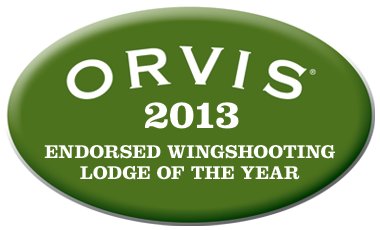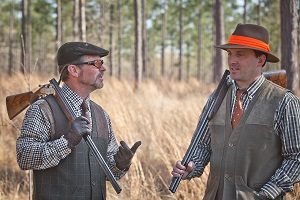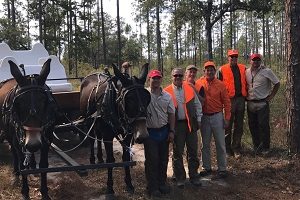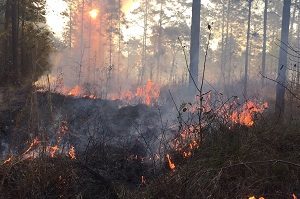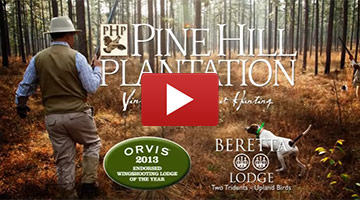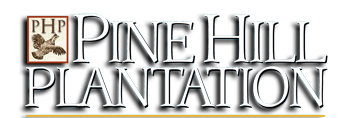Pine Hill Plantation’s goal is to produce authentic wild bobwhite quail habitat that offers an abundance of covey rise shooting opportunities for our Guests. At Pine Hill Plantation the birds flush as wild today as they did in the Golden Days of Vintage Georgia Quail Hunting!
There is nothing more exhilarating and challenging for shotgun wingshooters than to see a covey of 15 to 20 bob white quail flush all at once. We want you to be challenged by mother nature… when 20 birds get up at once… and your stomach jumps up into your throat… and your adrenaline is pumping… and then you try to pick out the right bird for the first shot… in hopes of getting a chance to get to a second shot… and bag the double off the covey rise.
So, what does it take to have great authentic wild quail habitat?
Long Term Commitment
At Pine Hill Plantation, we are passionate about preserving the history and tradition of plantation style quail hunting… and sharing it with avid wingshooters!
But those traditions and the ability to experience the history are quickly disappearing. Development is consuming land that was once open and available to hunt bob white quail in their natural wild habitat. Horses and mule-drawn wagons have become all but eclipsed by trucks and jeeps as technology and high production farming takes its toll on a passing era, in a time when things moved at a slower pace.
It is our passion that keeps us committed and investing millions of dollars to preserve the opportunity to hunt the way it was done in the Golden Days of Vintage Georgia Quail Hunting!!
The Right Kind of Habitat… in the Right Location
Pine Hill Plantation manages some of the best quail habitat in South Georgia consisting of long leaf pine timber with wiregrass understory… the native habitat to wild Georgia bob white quail. Located only 60 miles from the Gulf of Mexico and 40 miles west of Thomasville, GA our habitat enjoys a semi-tropical humid climate that produces an annual average rainfall of over 53 inches and is ideal for bob white quail.
Bob white quail are not hardy birds and our mild temperatures (average winter time lows in the 40s and average highs in the 60s – degrees F) allow them the most favorable chance for winter time survival. Even when we have extended periods of summer time draught, there is a dew most every morning in the pine forest from the coastal humidity which condenses under the pine canopy onto the native grasses of the forest floor allowing the birds to drink from the dew as it drips down on the native wiregrass.
With semi-tropical rains in the spring and summer, the understory in our pine forest is very dense which makes ideal brooding cover where young quail are well protected from both avian and mammalian predators. In spring and summer the insect population is high which makes an excellent source of protein intake for the birds.
With the arrival of fall and winter frosts, the pine forest begins to brown and much of the thick understory becomes more open. Yet native wiregrass, oak thickets and briar thickets provide excellent winter time cover… as well as producing seed which provides winter time feed.
Lots of Habitat Investment
At Pine Hill Plantation, a single hunt party will cover 250 to 300 acres each hunt day… so it takes a lot of land and a lot of resources to produce this quality of quail hunting. A wild covey of quail needs 5 to 15 acres of land for its natural habitat.
On many day release commercial quail plantations they may hunt 30 to 40 acres in a day and cover it largely by foot.
Pine Hill Plantation’s authentic methods of hunting require 8 to 10 times the amount of habitat used by many day release commercial quail plantations. Because we cover 8 to 10 times more habitat and move through the natural understory as we hunt… walking hunting is not very productive because of the distances between wild covey finds.
The historical reason that we hunt from horseback and mule-drawn wagon is primarily to be able to move quickly (faster than on foot) over longer distances from covey find to covey find. In the late 1800s and early 1900s when Georgia’s most prestigious private plantations were coming into their own… the horse was a primary and available mode of transportation… and mules were the primary farm “engine”.
It is Expensive… It is Authentic… and if you want the Real Thing… It is worth it!
When hunting authentic habitat from horseback and mule-drawn wagon a successful hunt requires 8 to 10 times the amount of habitat… and land is not inexpensive. If the dogs cover 8 to 10 times the amount of habitat… then you have to have more dogs.
A hunt party of 4 horses, 2 mules, a wagon, 10 to 12 pointing dogs, a retrieving dog, a wagon driver, a dog handler / assistant huntmaster and a huntmaster costs multiples of what it costs to hunt from a jeep with 4 to 5 multi-purpose dogs and a single hunt guide.
This experience is expensive to produce… it is Authentic… and for avid wingshooters who revel in the lifestyle of plantation quail hunting… it is worth every penny of it!!
Resident Wild Quail Populations
Our natural habitat and our proximity to the Gulf of Mexico assure us a great opportunity for wild bob white quail populations… but that alone doesn’t do the trick in today’s ecosystem. Quail today have many unnatural enemies from large scale farming practices and pesticides to predators that are out of natural balance such as coyotes, feral cats and hawks.
Resident wild quail populations are absolutely key to authentic quail hunting and all of our habitat management efforts are geared towards continual improvement to the survival, growth and prosperity of our wild quail populations.
Year-Round Investment in the Habitat Management
Across the whole year we spend an average of 7 days managing habitat, equipment and facilities for every day that we hunt. Over 60% of the hunting fees that we charge our Guests are spent for habitat management, hunt equipment and hunt animals (dogs, horses, mules)… and that is before we even consider the cost of our lodges, food, beverage and house staff.
We manage our habitat from the wildlife management science that was learned from our participation in the Albany project conducted by the Auburn University School of Wildlife Sciences from 1992 through 1998. That body of quail wildlife management knowledge is at the core of the Tall Timbers Research Center that is so vital to the management practices on most of the privately owned quail plantations in south Georgia and northern Florida.
We begin our habitat management year toward the end of our quail hunting season with prescribed controlled burning which stimulates natural grass cover reproduction which later produces seed for natural feed. Additionally, the controlled burning helps to hold the natural competing timber such as oak at optimal levels for hunting visibility vs. natural bird cover vs. competition with the pine timber. Burning is done in a checker board fashion so that wildlife always has adjacent habitat to which to retreat. In our semi-tropical climate with mild spring temperatures it is amazing how quickly the forest floor greens back up with natural cover within a couple of weeks following a burn.
Also, in the spring we renew our trapping efforts for mammalian predators such as bobcat, fox and raccoon. Traps are initially set on the perimeter of an area and are checked periodically. Over a period of several months, traps are moved in on smaller and smaller concentric perimeters until we are satisfied with the predator reduction results. Our goals is to reduce overpopulated predators to natural balance levels.
In late spring to early summer we begin planting additional cover areas. The cover plots are first cross cut, then fertilized, then cross cut again, then cultivated, then planted. Cover plots provide additional winter time cover for birds which is essential to their protection from avian predators as the natural cover thins with winter frosts and defoliation. Cover is one of the single most important factors in quail survival.
During summer we are busy mowing and spiral chopping areas where cover is too thick and cleaning up areas that have had select cut timber removal from timber harvest operations.
In late summer to early fall we supplement our wild quail populations with a genetically controlled juvenile age bird. Generally, in this time frame, the wild coveys are leaving the home covey and mixing with other birds. This is mother nature’s way of avoiding inbreeding and the time of season is referred to as “the fall shuffle”. Our goal is to roughly double our wild bird populations with the release of our genetically controlled juvenile age bird during this time of the fall shuffle when the wild birds are mixing and forming new coveys. Generally, we see the resulting coveys as a mix of wild birds and released birds. The science behind producing a genetically controlled bird that is capable of survival in the wild is complex and the cost is both labor intensive and expensive… and is multiples of the cost for a bird that you release and shoot in the same day. Keeping in mind that wild quail have an 80% mortality rate over a season, we expect the mortality rate of our genetically controlled release bird to be higher, so we will do one to two supplemental releases during our hunting season to supplement covey sizes. While very expensive to execute, these methods produce extraordinarily authentic results for exciting and challenging covey rise shooting into large coveys.
In the fall, we begin mowing roadways for wagon travel and mow breaks in the areas where cover is large and continuous. In late fall, we begin working dogs and training up younger dogs to get them ready for the upcoming hunting season.
From October through March we broadcast feed every two weeks into our planted cover as well as into natural cover. By feeding into good cover we encourage a higher likelihood of bird survival while feeding. Abundant feed assures healthy bird populations and helps to hold birds in an area when they have received hunting pressure.
Then come late October and November, we get to begin hunting… and that is why we do what we do.
Conservation Hunting Practices
Our goal is for high-challenge covey rise shooting… and wild resident quail coveys are key. We carefully manage our hunting rotation because hunting an area too often can pressure coveys to leave.
Taking too many birds from a covey too often can pressure coveys to leave… so we will not allow you to shoot more than 3 birds from a covey… unless both shooters shoot doubles off the rise. We do this to assure the quality of that authentic covey rise shooting… for you… for the next hunt group… and for the next season.
One of the key survival techniques for bob white quail is “safety in numbers”. When a covey of 20 birds flush, it is a lot harder to pick a single bird to shoot… a whole lot harder than if only 1 or 2 or 3 birds get up. The same is true for a predator when it goes after a covey. Therefore, mother nature has wired wild quail so that when a covey of wild bob white quail gets below 6 or 8 in number… they are going to leave that area and search for another covey to join where they can have 15, 20 or so birds in the covey.
The data from quail wildlife science tells us that wild resident quail populations in nature peak at 100% around late October and early November… and with natural predation the populations naturally drop to approximately 20% by early spring. That 20% remainder is naturally sufficient to allow mother nature to regenerate the resident population back to 100% by the following fall.
All of our habitat management techniques and conservation hunting practices are aimed at assuring that we have that natural 20% or greater wild resident quail population come spring time.
Finding the Birds
When we go out to hunt, we don’t know where the birds are. We, with the tremendous help of our dogs, have to hunt them. Quail give off the most scent trails when they are out walking around feeding. Quail feed more when it is cooler or when rain is soon to come… and feed less when it is warmer and when it is raining. Scenting conditions are best when it is moist… too much moisture (rain) can wash away the scent. Too little moisture and the dry, dusty ground will not hold scent… and on top of that the pointing dogs nose gets full of dust which certainly does not help sharpen their sense of smell. The pointing dogs typically smell the scent trail where the quail have been walking… and then follow that scent trail to where the birds actually are. When the birds are not feeding much, there is little or no scent trail to find… and the dogs have to find “the needle in the haystack”.
Almost never do we find all of the coveys in a given area… the birds are just too smart. But under the best conditions we may find 2/3 to ¾ of the coveys… and under the least favorable conditions we may only find ¼ of the coveys.
We Love What We Do…. And we know that You Will Too!!
Everything that we do to help our habitat stems from our passion for authentic Georgia bobwhite quail hunting. We know that you are going to enjoy the Vintage Georgia Quail Hunting at Pine Hill Plantation!
